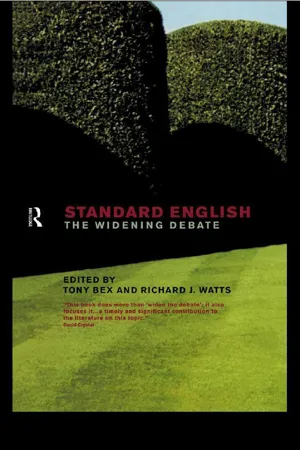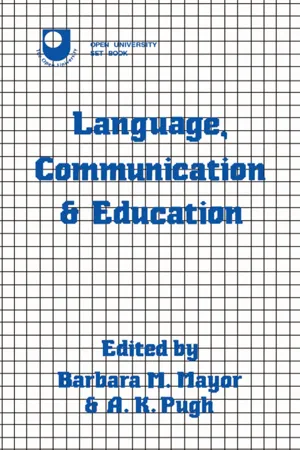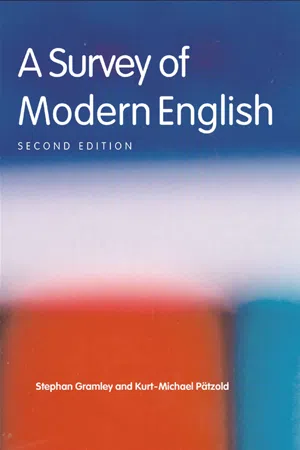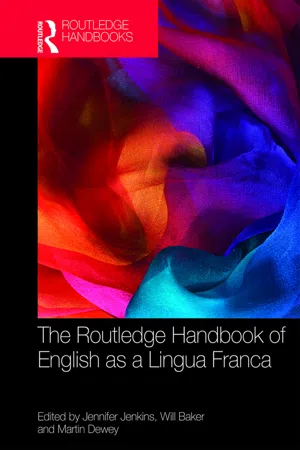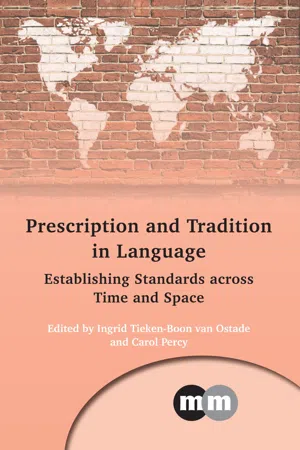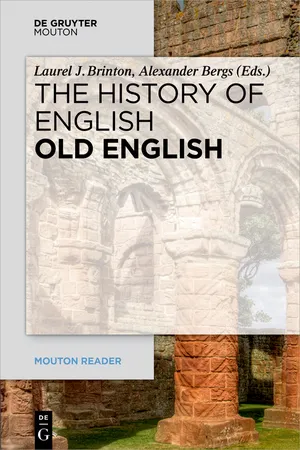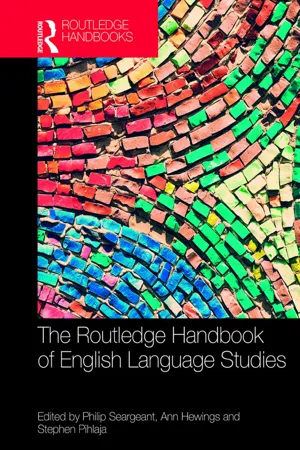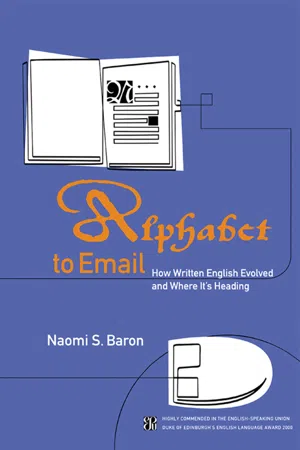Languages & Linguistics
Standardisation of English
Standardisation of English refers to the process of establishing a set of rules and conventions for the English language, including spelling, grammar, and vocabulary. This standardisation aims to promote uniformity and clarity in written and spoken communication, facilitating mutual understanding among speakers of different dialects and backgrounds. It also serves as a foundation for educational curricula and official communication.
Written by Perlego with AI-assistance
Related key terms
10 Key excerpts on "Standardisation of English"
- eBook - ePub
Standard English
The Widening Debate
- Tony Bex, Richard J. Watts(Authors)
- 2002(Publication Date)
- Routledge(Publisher)
Carter's final point is that pedagogic processes can gain a great deal not only from looking at this kind of data-driven research on oral corpora but also by comparing and contrasting spoken and written texts. In doing so, it will be seen that both media encompass a very wide range of genre types in which a wider set of variations must be allowed than the minimal variation in written English acceptable to the National Curriculum, and that the number of genre types in the oral medium will be far greater than those in the written medium. Carter is certainly not against teaching ‘Standard English’. Not to teach standard written English would be to disregard the need to teach English internationally as a second or a foreign language and it would ‘seriously disadvantage and disempower’ the native speaker. But to teach standard spoken English requires that we take on the task of showing what it is.The aspect of the debate which involves the spoken language is thus of central significance, and it will involve taking the data out to those who set themselves up as the guardians of ‘Standard English’ and allowing them to compare their own oral performance with those we have on tape. The argument might be: ‘Never mind what you think you say or should say. Focus on what you and others like you actually do say!’Passage contains an image
5 Standard English: What it Isn't
Peter TrudgillDOI: 10.4324/9780203054062-10There is a reasonably clear consensus in the sociolinguistics literature about the term standardised language: a standardised language is a language one of whose varieties has undergone standardisation. Standardisation, too, appears to be a relatively uncontroversial term, although the terminology employed in the discussion of this topic is by no means uniform. I myself have defined standardisation (Trudgill 1992) as ‘consisting of the processes of language determination, codification and stabilisation’. Language determination ‘refers to decisions which have to be taken concerning the selection of particular languages or varieties of language for particular purposes in the society or nation in question’ (ibid.: 71). Codification is the process whereby a language variety ‘acquires a publicly recognised and fixed form’. The results of codification ‘are usually enshrined in dictionaries and grammar books’ (ibid.: 17). Stabilisation is a process whereby a formerly diffuse variety (in the sense of Le Page and Tabouret-Keller 1985 - eBook - ePub
- Barbara Mayor, A. K. Pugh(Authors)
- 2005(Publication Date)
- Routledge(Publisher)
Section 2 Standardisation and Diversity in LanguagePassage contains an image
Introduction
DOI: 10.4324/9780203975107-8We are often encouraged to think of a language as if it were a homogenous entity. This impression is confirmed by the strong pressures, notably nowadays from the educational system, towards conformity to national norms or standards, especially in written language. However, linguists observe that languages which are still spoken are always in a state of change. To some extent this is because of various pressures to speak in certain ways. The language of a national high-status group is not the only one which enjoys prestige in a country. There are other allegiances to be demonstrated and confirmed through language. Most speakers are able to vary their accent and even within one person the consistency implied by standardisation will be very hard to find. The readings in this section clarify these issues. They also examine the factors of a social or political nature which contribute to the adoption of certain forms or varieties of language.In the first article in this section, Leith traces the development of standard English in four stages which he suggests are applicable to the growth of other standard languages. The final stage, codification, involves an attempt to eliminate the variation which exists within a language and to stem change. Leith considers that standardisation is as complete as it is ever likely to be in English, yet there remains considerable diversity in pronunciation and still some variation in grammar and in written forms.Variation in pronunciation is the subject of an influential article by Giles which is our second reading here. In a series of studies, Giles examined the factors which cause us to value certain accents under certain conditions. This included research into whether one moves more towards or away from the accent of the person one is speaking to. We may, for example, move nearer to received pronunciation (RP) in certain circumstances and more towards a local or regional accent in others. Giles was particularly interested in how our judgements on people’s qualities are affected by our perception of their accent. He found that the status of received pronunciation is not so unambiguously high as might be assumed and that while some favourable qualities are attributed to speakers of RP, other positive qualities are perceived in speakers who use other accents. - eBook - ePub
- Stephan E Gramley, Michael Pátzold(Authors)
- 2004(Publication Date)
- Routledge(Publisher)
Chapter 1 The English language Standards and variation 1.1 STANDARD ENGLISH There is little explicit agreement about just how Standard English (StE) should be regarded. Almost everyone who works with English assumes at least implicitly that it exists, but the descriptions made of it – for example, in dictionaries and grammar books, to say nothing of manuals of style – indicate that there is a certain amount of diversity in people’s ideas about StE. Yet, there are dictionaries, grammars and manuals of style, and what they document – some would say prescribe – is what is most often understood by StE (see 1.3 and 1.4). A standard language is used as a model in the speech community at large. In 1.3 you will read about four defining characteristics involved in the process of standardization: selection, acceptance, elaboration and codification. That this is necessary is evident in the cases of so many indigenous languages in Third World countries (see Chapter 14) which for lack of a native standard have adopted a standardized European language such as English, hoping in this way to ease the path to ‘economic prosperity, science and technology, development and modernization, and the attractions of popular culture’ and paying the price of loss of self-expression and diminishment in feelings of cultural worth (Bailey 1990: 87). The result is that ‘the old political empire with its metropolis and colonial outposts has nearly disappeared, replaced by a cultural empire of “English-speaking peoples"’ (ibid.: 83). This quotation indicates that codification can also be overdone if English becomes the instrument of cultural imperialism. In order for English to occupy a more deeply rooted position within post-colonial societies it must draw on the everyday usage of its speakers, and this includes the recognition not only of non-standard forms, but also of non-native ones - Jennifer Jenkins, Will Baker, Martin Dewey, Jennifer Jenkins, Will Baker, Martin Dewey(Authors)
- 2017(Publication Date)
- Routledge(Publisher)
Milroy provides a general definition, “the imposition of uniformity upon a class of objects” (2001: 351). This means that natural languages, which are by their nature non-uniform and variable, do not just become standard, they have standardization imposed upon them. The motivation for standardization is to stabilize the language in order to establish effective communicative conventions and a sense of common, often national, identity and security. There is also a practical motivation in providing institutional norms against which individual linguistic behaviour can be measured; hence the standard language is equated with standards of linguistic behaviour and educational achievement. p.87 While other standard languages, such as French, for example, are associated with national institutions such as academies, it is much less clear who undertakes the standardization of English, who has (had) the authority to do so. Apart from literary authors, especially in the eighteenth century (Wright 2006; Hickey 2015; Widdowson, Chapter 8 this volume), it is mainly language experts such as lexicographers and grammarians who decide what counts as the English standard language – which is then imposed by different kinds of institutional authority. StE is, then, an institutionalized construct, and only really possible when the language is written. And being dependent on literacy, StE is closely associated with education, as “the dialect normally used in writing, for teaching in schools and universities, and the one most often heard on British radio and television” (Hughes, Trudgill and Watt 2013: 13). It is, however, “a variety that is never perfectly and consistently realized in spoken use” (J. Milroy 2001: 543)- eBook - ePub
Prescription and Tradition in Language
Establishing Standards across Time and Space
- Ingrid Tieken-Boon van Ostade, Carol Percy(Authors)
- 2016(Publication Date)
- Multilingual Matters(Publisher)
Part 1 General and TheoreticalPassage contains an image
2 Defining ‘Standard’: Towards a Cross-Cultural Definition of the Language NormDick Smakman and Sandra Nekesa Barasa StandardnessThe standard language is generally considered a linguistic norm which a very large speech community overtly adheres to (Milroy, 1992: 3; Meyerhoff, 2011: 18). Standard languages are different from other varieties of the same language in that they tend to cover a larger area, are often codified and supported by governments and transcend some contact-induced influences (Thomason & Kaufman, 1988). Once they have emerged as standard and gone through a process of acceptance, they are mostly shaped through conscious efforts and are actively spread as an official norm, usually within a country (Smakman, 2012). Traditionally, standard languages can be found used as the linguistic medium in schoolbooks, in official documents, on national mainstream radio and television and, for instance, in official gatherings such as parliamentary sessions (Smakman, 2006). Standard languages tend to be highly visible in many societies. Despite this visibility, however, the standard language is an elusive phenomenon considering that the set of factors its definition depends on is unclear and debatable. Existing models on what a standard language is each take a different aspect of this language as its point of focus: features of the language itself (e.g. Stewart, 1968), position in society (how it is evaluated) (e.g. Hoenigswald, 1966), degree of codification (e.g. Stewart, 1968), characteristics of speakers (e.g. Kloeke, 1951) or, for instance, the historical developmental stages it has gone through, for which Haugen (1966) is usually drawn upon. - eBook - ePub
- Laurel Brinton, Alexander Bergs, Laurel Brinton, Alexander Bergs(Authors)
- 2017(Publication Date)
- De Gruyter Mouton(Publisher)
the standardless period of English. The absence of a standard is all the more a defining quality of Middle English because what we regard to be the “beginning of Middle English” coalesces with the disappearance of the so-called “West-Saxon Literary Standard”, so that Roy Liuzza (2000: 145) could claim that “the end of […] scribal training [in the West-Saxon standard] was the beginning of ‘Middle English’”. Moreover, in the last century of the Middle English period the vernacular is generally supposed to be under way towards Modern Standard English. Situated between the disappearing of one written standard and the slow emerging of a new standard, Middle English therefore “exhibits by far the greatest diversity in written language of any period before or since” (Milroy 1992: 156). The reasons for this linguistic scenario lie in the specific language situation resulting from the cultural impact of the Norman Conquest on the one end and the rapidly increasing use of English in writing for various purposes on the other.This chapter is structured in such a way that Section 2 discusses different concepts of the notions “standardization” and “standard” as they are applicable to Middle English. Section 3 subsequently discusses “standardized varieties” of English which have been identified mainly on the ground of unified spellings, and, in the 14th and 15th centuries, also in terms of the spread of dialectally bleached forms which could function supralocally. Section 4 then concentrates on the extensive and intensive elaboration of written English in the 14th and 15th centuries. Section 5 gives a brief summary of the main aspects addressed in the chapter.2Standardization(s) and standards
In general the idea of standardization is based on a concept of fixing and fixity of what would otherwise vary more or less freely. As the prime – and for a long time sole – means of fixing (a) language, writing potentially produces such models that minimize variation. However, writing is a necessary, but not a sufficient, condition for such a specific variety to emerge because it seems to take further socio-pragmatic motivations and textualization efforts for a standard variety to become established. Under “socio-pragmatic” shall be subsumed such standardizing moves that modify written language to serve a wider geographical range of communication. By “textualization efforts” I refer to orientation towards standards already established by existing literate models that will be called “discourse traditions”, a notion specifically apt to account for the unique literary communicative space of the period under consideration. As shall be seen, the former moves reduce variation while the latter efforts enhance variability. - eBook - ePub
- Laurel Brinton, Alexander Bergs, Laurel Brinton, Alexander Bergs(Authors)
- 2017(Publication Date)
- De Gruyter Mouton(Publisher)
Over the last centuries, most European languages with a written tradition have been affected by standardization processes. This development coincided with the rise of the nation-state, so that a language without a standard is nowadays hardly conceivable: “Nation and language have become inextricably intertwined. Every self-respecting nation has to have a language. Not just a medium of communication, a ‘vernacular’, or a ‘dialect’, but a fully developed language. Anything less marks it as undeveloped” (Haugen 1966: 927).Haugen also provides the four main reference points for a discussion of standardization processes, namelya.selection of norm; b.codification of form; c.elaboration of function; d.acceptance by the community (Haugen 1966: 933).Whereas (a) necessarily represents the first step in any standardization process and (d) its final stage, (b) and (c) may apply to different degrees at different times during the process, depending on the actual level of the language undergoing standardization (for a different view on the sequence of steps, see Deumert and Vandenbussche 2003: 4–7). In Coseriu’s terms, step (a) typically extends the range of one of the normsd that form part of languaged , such that, eventually, one normd(escriptive) becomes coextensive with the normp(rescriptive) for languaged : “the process of standardization works by promoting invariance or uniformity in language structure […] standardization consists of the imposition of uniformity upon a class of objects” (Milroy 2001: 531). Step (b), codification of form, is typically accomplished by dictionaries, grammars, usage guides, and in some cases academies; again, this stage is inconceivable without a high degree of literacy. Elaboration of function may happen before or parallel to codification; another common term for this process is Ausbau (following Kloss 1967, 1978), a notion that has recently been reconceptualized by Fishman (2008). Whereas steps (a) and (b) satisfy the demand of “minimal variation in form”, Ausbau - eBook - ePub
- Laurel Brinton, Alexander Bergs, Laurel Brinton, Alexander Bergs(Authors)
- 2017(Publication Date)
- De Gruyter Mouton(Publisher)
If William the Conqueror had not invaded England in the year 1066, standard English would have looked completely different today. Not only would the enormous French component in the English vocabulary have been considerably smaller, the standard language would in all likelihood have had its origin in a different dialect as well.Introducing the topic of “Standardisation” in the history of English, Terttu Nevalainen and Ingrid Tieken-Boon van Ostade (2006: 271) thus point to the fact that the story of Standard English is markedly discontinuous in chronological as well as in geographical terms. The standardizing process in pre-Conquest times which the above quotation alludes to is subsequently concretized as having “affected the West Saxon dialect, with Winchester as its main cultural centre” (2006: 271). While this statement can be said to be representative of traditional scholarly opinion, Richard Hogg in a handbook article on “Old English Dialectology” published in the same year takes a much more radical stance by concluding “that it is doubtful that there ever existed a variety of West Saxon which could properly be described as forming a ‘Standard Old English’” (Hogg 2006: 402).As will be shown in more detail in Section 2 , the history of research into standardization – just like its object of study – is by no means straightforward in its development. Current scholarship is still in search of an adequate descriptive framework for the normative processes operative in Old English that is suitable for capturing the differences between the notions of “standardization” and “a standard” in the earliest period of English as compared to its later stages (cf. Section 3 ). The major forms of standardization in Old English that have been established – the so-called “Winchester vocabulary” and “Standard Old English” – will be dealt with in Section 4 . Further instances of standardization that have been identified are briefly addressed in Section 5 .The divergences in scholarly interpretation become more understandable if we look at the nature of the available material. Due to its unusually rich and varied transmission of vernacular texts, Old English holds a unique position among the Germanic dialects. Still, the uneven distribution of the manuscript evidence over time and place and the restricted nature of the data make an adequate assessment of regularizing processes in Anglo-Saxon times difficult. Impressive as the vernacular legacy of the Anglo-Saxons may be, it is representative of a small and educationally privileged section of society only. Scholars in search of normative tendencies face in fact quite similar problems to those who look for variation, and it is from historical dialectology that research into standardization in Old English has received both major new impulses and serious challenges during the past few decades. - Philip Seargeant, Ann Hewings, Stephen Pihlaja, Philip Seargeant, Ann Hewings, Stephen Pihlaja(Authors)
- 2018(Publication Date)
- Routledge(Publisher)
The key area of dispute, particularly among language scholars, involves the nature of Standard English – which is a specific instantiation of a more general question concerning the nature of standards in language. This is not to say that such disputes do not take place in policy contexts or in society in general. But when such disputes occur in these latter domains, there is usually a presumption that language experts can provide a clear resolution to the matter; hence, there can be impatience and frustration when these experts do not agree among themselves or when they try to explain why the issue is actually a matter of some complexity.Basically, the main question relates to how seriously to take the notion of language change and therefore whether to conceive of Standard English as primarily a product or a process. This relates to another area of dispute, which is whether to understand the nature of Standard English in primarily linguistic or non-linguistic terms, where adopting the latter means giving serious recognition to the influences of social and political factors.No one would deny that the English language has undergone changes in grammar, lexis, and pronunciation. The issue therefore is to what extent such changes are considered negligible, such that the language can be said to be fundamentally the same. Once we acknowledge that what counts as standard inevitably changes because of the variation that inheres in the language practices of different speakers, and moreover, that there are ideological influences at work in deciding just what kind of variation to accept as being standard and what to reject as being non-standard, then we have to also acknowledge the inescapable relevance of non-linguistic factors in defining Standard English and, more generally, standards in English. In this regard, recall that Honey insists on ‘educatedness’ (1997: 235) as the hallmark of Standard English speakers, though he also allows for other, sufficiently ‘high-status’ individuals or circumstances (1997: 161–162):- eBook - ePub
Alphabet to Email
How Written English Evolved and Where It's Heading
- Naomi S. Baron(Author)
- 2002(Publication Date)
- Routledge(Publisher)
153 Since World War II, American English has been insinuating its way into international pride of place, not so much by design as through the pervasive reach of American radio, movies, television, music, and now the Internet. Add to this mix thousands of footloose non-RP, non-NBC-Broadcasterese speakers of English who have been traversing the globe teaching the language (with their own accents, of course), and you have a dialectal jumble that would cause Sheridan to shudder in his grave.How do would-be learners of English around the world feel about having outsiders (native speakers though they be) dictating language standards? The burgeoning literature on world Englishes documents growing tensions between traditional British or American standards and what Braj Kachru has called members of the “outer circle” (former members of the British Empire such as India and Singapore, where English is not a native language, but is extensively used in government) and the “expanding circle” (nations such as the People’s Republic of China or Poland, which were not British colonies but make extensive use of English as an auxiliary international language).154 At the local level, varieties of English that differ not only in pronunciation but in lexicon and grammar are gaining legitimacy as languages appropriate for national newsmedia, literature, and even schooling.Where does this leave “standard” English? One increasingly frequent answer is that whatever linguistic developments may emerge locally, a globally recognized standard will still be needed for higher education, research, the international media, transportation, commerce, and technology. Tom McArthur speaks of an International Standard English; David Crystal refers to World Standard English.155What might this standard look like? The least common denominator of British and American English. Crystal describes users of such world standards as “consciously avoiding a word or phrase which you know is not going to be understood outside your own country,” much the way General American, as broadcast on radio and television, avoids clear regionalisms.156
Index pages curate the most relevant extracts from our library of academic textbooks. They’ve been created using an in-house natural language model (NLM), each adding context and meaning to key research topics.
